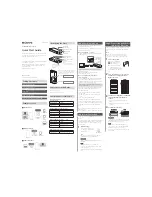
LSI Corporation
- 37 -
12Gb/s MegaRAID SAS Software User Guide
March 2014
Chapter 2: Introduction to RAID
RAID Configuration Strategies
Table 16 RAID Levels and Performance
2.3.3
Maximizing Storage Capacity
Storage capacity is an important factor when selecting a RAID level. There are several variables to consider. Striping
alone (RAID 0) requires less storage space than mirrored data (RAID 1) or distributed parity (RAID 5 or RAID 6). RAID 5,
which provides redundancy for one drive failure without duplicating the contents of entire drives, requires less space
than RAID 1. The following table explains the effects of the RAID levels on storage capacity.
RAID
Level
Performance
0
RAID 0 (striping) offers excellent performance. RAID 0 breaks up data into smaller blocks and then writes a block to each drive in the
drive group. Disk striping writes data across multiple drives instead of just one drive. It involves partitioning each drive storage space
into stripes that can vary in size from 8 KB to 1024 KB. These stripes are interleaved in a repeated sequential manner. Disk striping
enhances performance because multiple drives are accessed simultaneously.
1
With RAID 1 (mirroring), each drive in the system must be duplicated, which requires more time and resources than striping.
Performance is impaired during drive rebuilds.
5
RAID 5 provides high data throughput, especially for large files. Use this RAID level for any application that requires high read request
rates, but low write request rates, such as transaction processing applications, because each drive can read and write independently.
Because each drive contains both data and parity, numerous writes can take place concurrently. In addition, robust caching algorithms
and hardware-based exclusive-or assist make RAID 5 performance exceptional in many different environments.
Parity generation can slow the write process, making write performance significantly lower for RAID 5 than for RAID 0 or RAID 1. Drive
performance is reduced when a drive is being rebuilt. Clustering can also reduce drive performance. Environments with few processes
do not perform as well because the RAID overhead is not offset by the performance gains in handling simultaneous processes.
6
RAID 6 works best when used with data that requires high reliability, high request rates, and high data transfer. It provides high data
throughput, data redundancy, and very good performance. However, RAID 6 is not well suited to tasks requiring a lot of writes. A RAID
6 virtual drive has to generate two sets of parity data for each write operation, which results in a significant decrease in performance
during writes. Drive performance is reduced during a drive rebuild. Environments with few processes do not perform as well because
the RAID overhead is not offset by the performance gains in handling simultaneous processes.
00
RAID 00 (striping in a spanned drive group) offers excellent performance. RAID 00 breaks up data into smaller blocks and then writes a
block to each drive in the drive groups. Disk striping writes data across multiple drives instead of just one drive. Striping involves
partitioning each drive storage space into stripes that can vary in size from 8 KB to 1024 KB. These stripes are interleaved in a repeated
sequential manner. Disk striping enhances performance because multiple drives are accessed simultaneously.
10
RAID 10 works best for data storage that need the enhanced I/O performance of RAID 0 (striped drive groups), which provides high
data transfer rates. Spanning increases the capacity of the virtual drive and improves performance by doubling the number of spindles.
The system performance improves as the number of spans increases. (The maximum number of spans is 8.) As the storage space in the
spans is filled, the system stripes data over fewer and fewer spans, and RAID performance degrades to that of a RAID 1 or RAID 5 drive
group.
50
RAID 50 works best when used with data that requires high reliability, high request rates, and high data transfer. It provides high data
throughput, data redundancy, and very good performance. Spanning increases the capacity of the virtual drive and improves
performance by doubling the number of spindles. The system performance improves as the number of spans increases. (The maximum
number of spans is 8.) As the storage space in the spans is filled, the system stripes data over fewer and fewer spans and RAID
performance degrades to that of a RAID 1 or RAID 5 drive group.
60
RAID 60 works best when used with data that requires high reliability, high request rates, and high data transfer. It provides high data
throughput, data redundancy, and very good performance. Spanning increases the capacity of the virtual drive and improves
performance by doubling the number of spindles. The system performance improves as the number of spans increases. (The maximum
number of spans is 8.) As the storage space in the spans is filled, the system stripes data over fewer and fewer spans, and RAID
performance degrades to that of a RAID 1 or RAID 6 drive group.
RAID 60 is not well suited to tasks requiring a lot of writes. A RAID 60 virtual drive has to generate two sets of parity data for each write
operation, which results in a significant decrease in performance during writes. Drive performance is reduced during a drive rebuild.
Environments with few processes do not perform as well because the RAID overhead is not offset by the performance gains in handling
simultaneous processes.
Содержание ThinkServer RD650
Страница 1: ...ThinkServer 12 Gb s MegaRAID SAS Software User Guide ...
Страница 417: ......
Страница 418: ......
















































